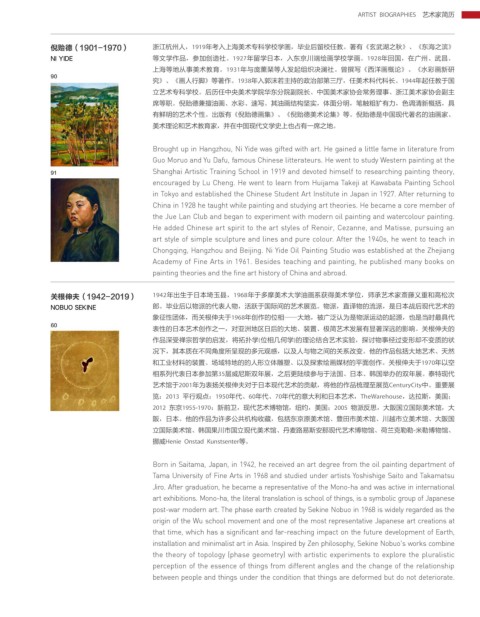Page 325 - 二十世纪及当代艺术
P. 325
ARTIST BIOGRAPHIES 艺术家简历
倪贻德(1901-1970) 浙江杭州人,1919年考入上海美术专科学校学画,毕业后留校任教。著有《玄武湖之秋》、《东海之滨》
NI YIDE 等文学作品,参加创造社。1927年留学日本,入东京川端绘画学校学画。1928年回国,在广州、武昌、
上海等地从事美术教育。1931年与庞薰琹等人发起组织决澜社。曾撰写《西洋画概论》、《水彩画新研
90
究》、《画人行脚》等著作。1938年入郭沫若主持的政治部第三厅,任美术科代科长。1944年起任教于国
立艺术专科学校。后历任中央美术学院华东分院副院长、中国美术家协会常务理事、浙江美术家协会副主
席等职。倪贻德兼擅油画、水彩、速写。其油画结构坚实,体面分明,笔触粗犷有力,色调清新概括,具
有鲜明的艺术个性。出版有《倪贻德画集》、《倪贻德美术论集》等。倪贻德是中国现代著名的油画家、
美术理论和艺术教育家,并在中国现代文学史上也占有一席之地。
Brought up in Hangzhou, Ni Yide was gifted with art. He gained a little fame in literature from
Guo Moruo and Yu Dafu, famous Chinese litterateurs. He went to study Western painting at the
91 Shanghai Artistic Training School in 1919 and devoted himself to researching painting theory,
encouraged by Lu Cheng. He went to learn from Huijama Takeji at Kawabata Painting School
in Tokyo and established the Chinese Student Art Institute in Japan in 1927. After returning to
China in 1928 he taught while painting and studying art theories. He became a core member of
the Jue Lan Club and began to experiment with modern oil painting and watercolour painting.
He added Chinese art spirit to the art styles of Renoir, Cezanne, and Matisse, pursuing an
art style of simple sculpture and lines and pure colour. After the 1940s, he went to teach in
Chongqing, Hangzhou and Beijing. Ni Yide Oil Painting Studio was established at the Zhejiang
Academy of Fine Arts in 1961. Besides teaching and painting, he published many books on
painting theories and the fine art history of China and abroad.
关根伸夫(1942-2019) 1942年出生于日本埼玉县,1968年于多摩美术大学油画系获得美术学位,师承艺术家斎藤义重和高松次
NOBUO SEKINE 郎。毕业后以物派的代表人物,活跃于国际间的艺术展览。物派,直译物的流派,是日本战后现代艺术的
象征性团体,而关根伸夫于1968年创作的位相—大地,被广泛认为是物派运动的起源,也是当时最具代
60
表性的日本艺术创作之一,对亚洲地区日后的大地、装置、极简艺术发展有显著深远的影响。关根伸夫的
作品深受禅宗哲学的启发,将拓扑学(位相几何学)的理论结合艺术实验,探讨物事经过变形却不变质的状
况下,其本质在不同角度所呈现的多元观感,以及人与物之间的关系改变。他的作品包括大地艺术、天然
和工业材料的装置、场域特地的的人形立体雕塑、以及探索绘画媒材的平面创作。关根伸夫于1970年以空
相系列代表日本参加第35届威尼斯双年展,之后更陆续参与于法国、日本、韩国举办的双年展。泰特现代
艺术馆于2001年为表扬关根伸夫对于日本现代艺术的贡献,将他的作品梳理至展览CenturyCity中。重要展
览:2013 平行观点:1950年代、60年代、70年代的意大利和日本艺术,TheWarehouse,达拉斯,美国;
2012 东京1955-1970:新前卫,现代艺术博物馆,纽约,美国;2005 物派反思,大阪国立国际美术馆,大
阪,日本。他的作品为许多公共机构收藏,包括东京原美术馆、豊田市美术馆、川越市立美术馆、大阪国
立国际美术馆、韩国果川市国立现代美术馆、丹麦路易斯安那现代艺术博物馆、荷兰克勒勒-米勒博物馆、
挪威Henie Onstad Kunstsenter等。
Born in Saitama, Japan, in 1942, he received an art degree from the oil painting department of
Tama University of Fine Arts in 1968 and studied under artists Yoshishige Saito and Takamatsu
Jiro. After graduation, he became a representative of the Mono-ha and was active in international
art exhibitions. Mono-ha, the literal translation is school of things, is a symbolic group of Japanese
post-war modern art. The phase earth created by Sekine Nobuo in 1968 is widely regarded as the
origin of the Wu school movement and one of the most representative Japanese art creations at
that time, which has a significant and far-reaching impact on the future development of Earth,
installation and minimalist art in Asia. Inspired by Zen philosophy, Sekine Nobuo's works combine
the theory of topology (phase geometry) with artistic experiments to explore the pluralistic
perception of the essence of things from different angles and the change of the relationship
between people and things under the condition that things are deformed but do not deteriorate.

